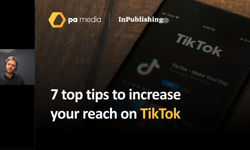
“We have TikTok for a reason, and let’s face it, the only [Instagram] reels uploaded are recycled TikToks and content that the world has already seen,” stated the petition that Kim Kardashian and Kylie Jenner shared last month, urging the photo-sharing platform to “stop trying to be TikTok”. While short-form, vertical, and mobile-led is clearly the future of social video, nobody can deny that TikTok's addictive algorithm and Gen Z fanbase laid the foundations of this trend when it was launched worldwide in 2018, becoming the third fastest-growing company in 2020, and surpassing one billion users at the start of 2022. According to Statista, in one ‘internet minute’, 167 million TikTok videos are watched – so it goes without saying that all publishers should want one of their videos in that number.
HELLO! magazine joined TikTok in August 2019 after seeing the potential of the platform to tap into an audience away from our magazine and website, but it soon became our way of testing rough-and-ready content, and, once we became more familiar with the app, learning more about the emerging consumer: Gen Z. For example, one of our most surprising finds was how much engagement royal videos would get, even more so than celebrity or lifestyle posts, which became a key to our videos’ success, and also reinforced our wider social strategy on other platforms, such as Snapchat and Instagram.
It also pivoted our social video production to editing on a phone, months before Reels and YouTube shorts – if you think of it this way, publishers have been optimising web content for mobile for years, always checking how pages look and load on a phone, but before the ability to edit video on a (very) small screen, we weren’t taking a step back to see how it would look to the majority of our customers. Fiddling with font size and placement with our thumbs hasn’t just made content easier to create for non-professionals, it’s also allowed professionals to tailor their content to the app’s style. We quickly learnt that on-site videos resized into vertical simply weren’t good enough, and ones completely built in the app achieved much higher views.
Onboarding early as a publisher on TikTok allowed us to use trial and error to work out what performed best, and this became clear from our first handful of videos. Views from red carpet press pens, clips from our magazine’s royal correspondent at Kate Middleton’s engagements, and in-office mundanity raked in hundreds of thousands of views in the first few months. Unfortunately, global events in March 2020 made that strategy redundant, and to keep posting regularly, we pivoted to reposting videos provided from royal accounts, edited in the app to keep the style. The Queen talking about her vaccine and Kate Middleton’s Zoom call got a combined view count of one million, and Meghan Markle’s virtual appearances at the GirlUp Leadership Summit, America’s Got Talent and various other shows also tallied up to a million. Although our strategy had changed, the fact we already had a strong number of videos on the app meant that they were still landing on the ‘for you’ page of the millions of new users in 2020 and 2021, proving why joining early is crucial.
What do publishers need to know?
Firstly, never label the app as simply ‘full of teenagers dancing’; it wasn’t true back in 2019, and it’s certainly not the case today. Dismissing TikTok for not aligning with your brand (too young, too informal, too silly) ignores the fact it was the most downloaded app of 2020 and 2021, therefore capable of reaching millions of new pairs of eyes. And now, it’s not just users scrolling aimlessly through the ‘for you’ page, which is dictated by their addictive algorithm, as Gen Z are starting to use TikTok over Google to find recommendations and answers.
Google’s senior vice president of Google Knowledge and Information, Prabhakar Raghavan, revealed at a conference in Aspen earlier this year: “In our studies, something like almost 40% of young people, when they’re looking for a place for lunch, they don’t go to Google Maps or Search – they go to TikTok or Instagram. We keep learning, over and over again, that new internet users don’t have the expectations and the mindset that we have become accustomed to. The queries they ask are completely different.”
If you tap the magnifying glass icon in the top right corner of the app, you can see the ‘suggested searches’ look very similar to google SEO queries: for example, ‘Liam Payne & Cheryl’, ‘Trainspotting Guy Saying Goodbye’ and ‘Harry Styles Yelling At Fan Crying’.
So what can publishers look to post?
Pasta recipes, hair-curling tutorials, low downs on global conflicts, and magic trick instructions: there are hundreds of videos on each topic, and they’re visual, concise, and often under a minute. Even Jamie Oliver’s 15-minute meals and BBC bitesize can’t compete. Any publisher familiar with an SEO explainer can experiment with putting it to video. Lifestyle brands can chop their beauty content to swiftly edited tutorials, although it’s crucial to make sure that these are not simply on-site videos cropped to vertical. Tech titles can give honest and visually engaging reviews, or unbox exciting products – hitting those ‘iPhone 14 review’ search terms.
What’s more, you can use the resource you already have in your team. Anyone can film on a phone (even those unbelievably slick transitions), and instead of costly training courses, there are heaps of tutorials available online. The Gen Z generation began in 1997, meaning they’re just entering the professional workforce now, and their potential fluency in the app can bring more to a role than formal qualifications. Whenever there’s a spelling error in a brand tweet, everyone makes the same joke about ‘the intern looking after the Twitter account’, despite everyone in the industry knowing that’s never the case. However, in the case of TikTok, it’s most certainly a good thing to have an intern helping with the account.
Nevertheless, especially in the early days, it’s best to ignore your usual KPIs when exploring TikTok. It won’t convert to traffic and isn’t a guaranteed way of generating revenue: see it as brand awareness, spearheading your short, vertical video strategy, and an extra platform to trial and error video series.
What have been the standout moments for HELLO!?
The biggest success for HELLO! was during the Queen’s Platinum Jubilee this year, where our traditional royal content with a TikTok spin landed us 48 million views for four days worth of videos – that’s over four times the amount of people that tuned into BBC’s Platinum Party at the Palace concert, which scooped up 11.2million viewers, and five times as many people who watched Trooping The Colour, the Queen’s annual birthday parade. We learnt from covering other main events (for example, the BAFTAs and Academy Awards) to always prepare enough video resource to cover TikTok – and the post-event numbers speak for themselves.
How can TikTok elevate your video strategy?
It goes without saying that simply repurposing content on multiple platforms is a dull strategy; the apps themselves don’t value it, and, just as Kim and Kylie said, their frustration with Instagram comes from the fact that Reels are simply ‘recycled TikToks and content the world has already seen’. Even if HELLO! has produced the same concept for numerous platforms, each video is edited in the app itself. It may be time-consuming, but having a video visually match each platform, for example, in font, is critical, even if the initial edit was done on desktop. Editing the look and feel of the video on the same screen that users consume it – and signing it off by watching it on a phone – ensures it’s legible and engaging.
The future of TikTok
As people complain of apps ‘trying to be TikTok’, TikTok itself is still pioneering enough to introduce new features for mobile video, which are quickly adopted by other platforms. Take the original ‘duet’ing for example, where users could react, debunk, or add layers to viral TikToks – Instagram is now pushing its ‘remix’ing feature, encouraging users to do similar. Same with longer videos – TikTok scrapped the 60-second limit to allow videos up to 10 minutes last year, and this summer, Instagram collated their reels and video pages to permit videos of up to an hour. However, live videos and disappearing ‘stories’ were features added later to TikTok, echoing Snapchat, Instagram, and Facebook’s most popular elements. And now, with Instagram’s new ‘dual camera’ setting looking nearly identical to BeReal, we can surely expect more features on TikTok, whether brand new or recycled from others.
It’s also inevitable that the user generated content on the app will become more and more premium; creators are becoming more skilled, and mobile phones are constantly upgrading their camera software to help create those sharp, slick ‘how did they do that?’ transitions.
With TikTok downloads not even beginning to slow down, publishers should be planning ways to weave TikTok into their video resource as much as possible. Not just for the future of the app itself, but laying the foundations for the next short-form video sharing platform. Talk to your youngest staff members, or even family members, for ideas, and always hold time for it in forward planning meetings. Finally, if you haven’t downloaded it, you’re missing out – it’s the users, not just the brands and publishers that make TikTok what it is. You might come up with a great idea for an office meme, or you might just find a new risotto recipe in your first scroll – but there’s nothing to lose, and quite literally, millions of reasons to try.
- This article was written a few weeks before the death of the Queen.
This article was first published in InPublishing magazine. If you would like to be added to the free mailing list to receive the magazine, please register here.












